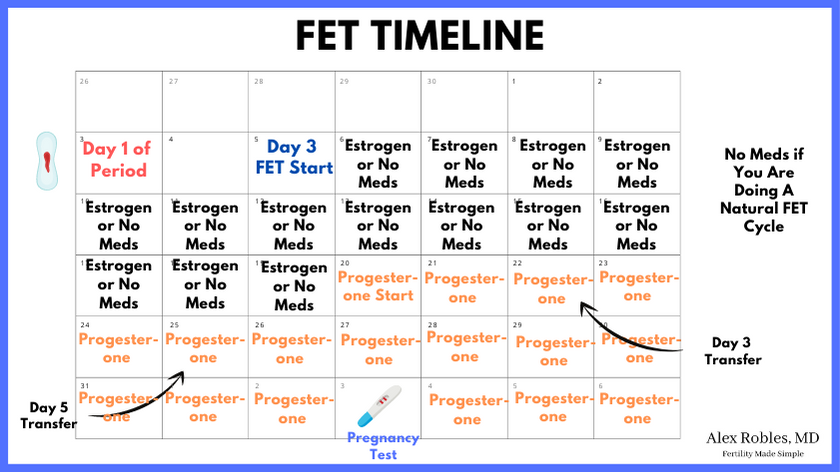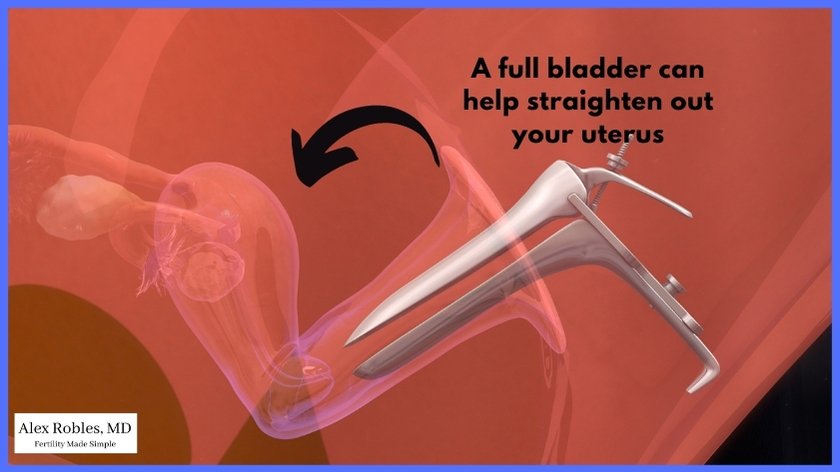In this post, you are going to learn all the steps of a frozen embryo transfer.
I’ll answer common questions like:
- What are the steps for a frozen embryo transfer?
- How many days after your period does the transfer take place?
- Are frozen embryo cycles better than fresh cycles?
Let’s get started.

When is A frozen embryo transfer done in IVF?
A frozen embryo transfer can be done at any point in the future if you have already undergone an in vitro fertilization (IVF) cycle that generated usable embryos.
In other words, it can happen as soon as the next cycle after your egg retrieval or several months (or years) later.
How long does a frozen transfer cycle take?
A frozen embryo transfer cycle lasts approximately 3-4 weeks. The first two weeks will prepare your uterine lining for implantation. Once your lining is ready, you will begin progesterone supplementation at some point in the third week.
The embryo transfer then takes place after 3 or 5 days of progesterone support.
What is the timeline for a frozen embryo transfer? (Day by day)
Now let’s break down the steps of a frozen embryo transfer (FET) cycle, day by day.
Step 0: Prep Work
If you are using your own eggs/embryos, you will first need to undergo an IVF cycle.
The IVF process and the freezing of any usable embryos usually take 2-3 weeks. You can read my post on The IVF Cycle Timeline to learn more.
If you already have embryos frozen, speak with your doctor to determine if you are eligible to begin a FET right away.
Many fertility specialists will have you come back for a consultation to determine if you should do a medicated FET cycle vs. a natural FET cycle.
You may also need a uterine cavity evaluation (saline sonogram or a hysteroscopy) or a mock transfer before proceeding.
Once everything is cleared, you will be instructed by your fertility clinic to call or email to report cycle day 1 of your period.

Day 1:
Day 1 refers to the first day of your menses. After informing your clinic, you will be scheduled to come in on Day 2,3 or 4 of your cycle to potentially begin the FET cycle.
Day 2,3 or 4:
On Days 2-4 of your menstrual cycle, you will come in for morning monitoring, a transvaginal ultrasound scan, and blood work.
If the ultrasound looks normal and your hormone levels are “baseline,” you will begin your FET cycle that day.
If you are doing a medicated FET cycle:
You will begin estrogen supplementation on this day.
The estrogen tablets do two things: It thickens the lining of your uterus and prevents an ovarian follicle from growing.
You will come back in about a week or so to check on the progress of your lining.
If you are doing a natural cycle:
You won’t be starting any medications. You will simply come back in about a week or so to check on the progress of your lining.
Days ~10-14:
At your second morning monitoring visit, your lining should be increasing in thickness.
The goal is to get your lining to ~ 7mm in size.
If you are doing a medicated cycle:
If your lining is growing as expected, you will be given a start date for progesterone supplementation.
This usually involves intramuscular progesterone injection with or without progesterone vaginal suppositories.
If you are doing a natural cycle:
Your lining should be thicker, and you should have a dominant ovarian follicle growing.
Your reproductive endocrinologist may wait for your body to begin the ovulation process (aka, your blood tests show that your LH hormone is surging).
In this case, your doctor may or may not have you take a trigger shot to start ovulation.
Day ~15-18:
At some point after the two-week mark, you will begin progesterone.
If you are doing a medicated FET cycle:
You will start intramuscular progesterone shots once your doctor has deemed that your lining is appropriate.
You will administer the progesterone injection twice on the first day and then once every day after that.
The embryo transfer procedure will then be scheduled:
- on the sixth day of progesterone injections (if you are having a blastocyst stage embryo transfer)
- on the fourth day of progesterone injections (if you are having a cleavage stage Day 3 embryo transfer)
If you are doing a natural FET cycle:
You will begin progesterone suppositories on the day after your trigger shot (or the day after you ovulate).
The embryo transfer procedure will then be scheduled:
- on the sixth day of progesterone suppositories (if you are having a blastocyst transfer)
- on the fourth day of progesterone suppositories (if you are having a cleavage stage Day 3 embryo transfer)
Day ~19-24:
This is the day of the embryo transfer. It is a simple procedure that shouldn’t take more than 20 minutes.
You will be expected to come with a full bladder, which will help visualize and guide the catheter containing the embryo into your uterus.
To learn more about what to expect on the day of the embryo transfer, check out: Embryo Transfer Precautions: What Not To Do.

Day~28-32:
You will then have your first pregnancy test no sooner than 9-11 after the transfer!
How many days after FET does implantation occur?
We believe that an embryo will implant in the first 24-48 hours after the FET. You likely won’t feel anything either way except for very mild cramping.
Can I do a pregnancy test 8 days after embryo transfer?
We highly recommend waiting at least 9-11 days after the transfer to avoid getting a false negative.
Before that time, the human chorionic gonadotropin, aka hCG levels are not high enough to yield a positive home pregnancy test.
It is much better to get a quantitative hCG blood test at your doctor’s office after 9-11 days.
How many weeks pregnant are you after IVF frozen transfer?
You are approximately 2 weeks and 5 days pregnant on the day of a blastocyst embryo transfer (assuming that it works).
By the time you have a positive pregnancy test ~9 days later, you will be approximately 4 weeks pregnant.
What are typical 5 day frozen embryo transfer success rates?
However, the success rate of an untested frozen embryo transfer can go as low as 20-30%, decreasing with increasing maternal age.
Here are some recent studies: [1] [2] [3]
Check out my post on Embryo Biopsy to see if you are a good candidate for genetic screening.
Why do frozen embryo transfers fail?
Unfortunately, we don’t always know why some embryo transfers fail.
In general, there can be an embryo quality issue, an implantation failure, or other endometrial lining issues that we don’t quite understand yet.
Preimplantation genetic testing can help control for numerical chromosomal abnormalities, but it cannot test for all types of genetic conditions that can exist.
What can you do after embryo transfer to increase success rates?
Unfortunately, there is not a lot that you can do to ensure a successful pregnancy.
You have already done everything within your power. The rest is up to the embryo.
You do not need bed rest. Also, it is a good idea to avoid any increased temperatures for the first 1-2 weeks following the transfer.
In addition, you should try to eat a healthy diet and stay well hydrated.
Are FETs better than fresh embryo transfers?
However, many studies have shown that pregnancy rates and live birth rates are similar for many patients.
With that said, many patients are not good candidates for a fresh embryo transfer.
Check out my post on Freeze-All IVF cycles to learn when you should freeze your embryos, and my other post on the disadvantages of frozen embryo transfer cycles to help you make an informed decision.
Conclusion
You now understand the FET cycle timeline as it relates to an IVF treatment cycle.
FETs are a great way to provide flexibility in planning the timing of your pregnancy, as any generated embryos can be stored indefinitely for future use.
If you have any questions regarding the next step, you might be interested in reading:
- Pregnancy Testing After An IVF Transfer: When To Check & Why
- When Should You Stop Estrogen And Progesterone After IVF (And Why)
- The Period After A Failed Treatment Cycle: (What You Should Expect)
Make An Appointment With Dr. Robles To Discuss Your Fertility Options Today!

Alex Robles, MD
Dr. Alex Robles is a Spanish-speaking Latino-American Reproductive Endocrinologist and Infertility specialist in New York City, and a board-certified OBGYN. He has a special interest in health, lifestyle, & nutrition. Make an appointment with Dr. Robles to discuss your fertility options today!
References:
- Bdolah Y, Zeimet R, Aizenman E, Lossos F, Abram TB, Shufaro Y. Frozen-Thawed Embryo Transfer Success Rate is Affected by Age and Ovarian Response at Oocyte Aspiration Regardless of Blastomere Survival Rate. JABRA Assist Reprod. 2015 Nov 1;19(4):210-5. DOI: 10.5935/1518-0557.20150041. PMID: 27203194.
- Veleva Z, Orava M, Nuojua-Huttunen S, Tapanainen JS, Martikainen H. Factors affecting the outcome of frozen-thawed embryo transfer. Hum Reprod. 2013 Sep;28(9):2425-31. DOI: 10.1093/humrep/det251. Epub 2013 Jun 11. PMID: 23756705.
- Roque M, Haahr T, Geber S, Esteves SC, Humaidan P. Fresh versus elective frozen embryo transfer in IVF/ICSI cycles: a systematic review and meta-analysis of reproductive outcomes. Hum Reprod Update. 2019 Jan 1;25(1):2-14. DOI: 10.1093/humupd/dmy033. PMID: 30388233.
